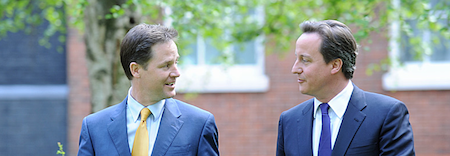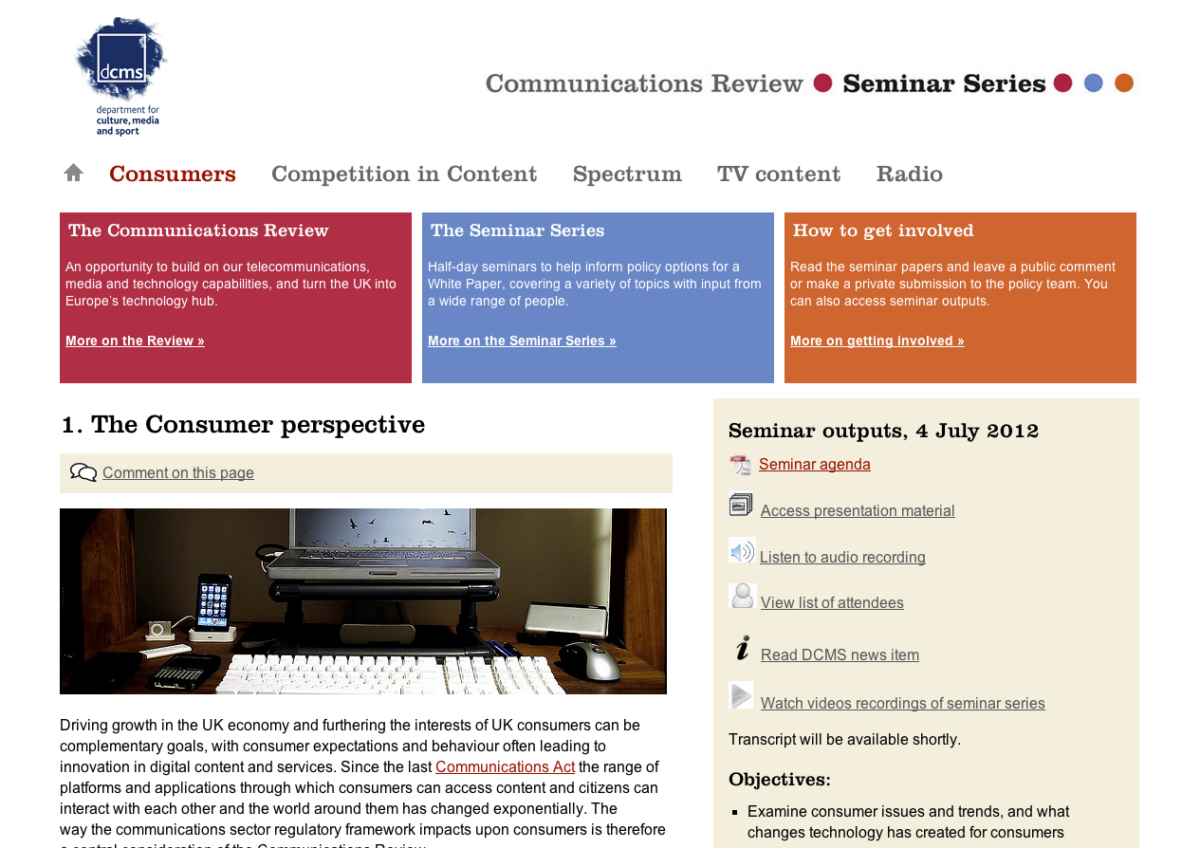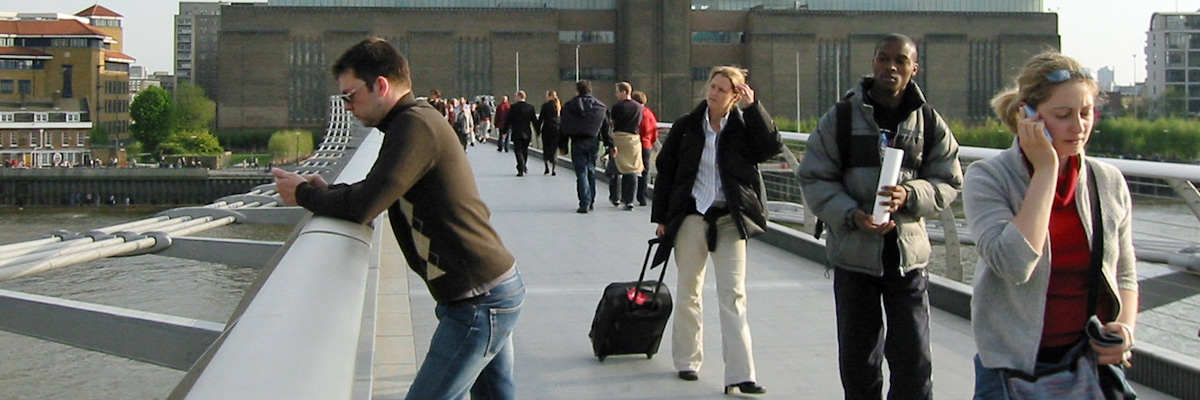So, a week into a new kind of government, what does the outlook for digital look like?
In terms of public sector IT at least, it looks broadly as through the principles and plans outlined by the Conservatives over the last six months are being brought into effect, with added emphasis on civil liberties.
Looking at the speeches, publications and campaign style of the Conservatives – and in particular Francis Maude (Cabinet Office, focus on efficiency & IT strategy), Jeremy Hunt (DCMS, dot com entrepreneur), George Osborne (Chancellor and open source fan) and Grant Shapps (digitally-engaged MP) – there seem to be three big ideas about the role and potential of the internet:
- Transparency: the internet as a publishing medium for government spending and Parliamentary expenses, to unleash ‘armchair auditors’ on government and politics to rebuild trust and promote consumer choice, e.g. publishing all government spending over £25k;
- Collaborative individualism: the internet as a decentralised network enabling individuals to come together as civil society to support their communities both altruistically and as an alternative mode of service provision to traditional state-run models, e.g. Wikipedia, the open source movement, involving the public in a ‘public reading stage’ of new Bills in Parliament;
- Efficiency: the internet as a lower-cost approach to delivering government IT programmes effectively including through smaller and more modular approaches, e.g. hosting health records via Google or Microsoft, increasing procurement from SMEs, and prohibiting the signing of very large (>£100m) IT contracts.
But what does that mean for jobbing webbies in the public sector? (n.b. of which I am no longer one, but more on that on a future occasion) Here are my predictions:
- Government IT will become more agile. Big IT is in a weak position right now, with unhappy customers having to work around the straightjacket of long-term contracts, and a Treasury review of all big contracts signed since the start of the year. There are serious and repeated suggestions of a government skunkworks as part of a more radical rethink of the recently published Government IT strategy. Sure, big desktop contracts and the planned gCloud are not likely to go away soon, but underneath their feet, there will be a strong expectation from the centre of government that digital should move fast, be cheap and learn from its own (small) mistakes. Likelihood of happening: 60%.
- Departments will begin to involve civil society in delivery, as well as policy. The ‘post bureaucratic age’ concept is a provocative label for a concept with much broader agreement: that addressing the deficit demands a slightly smaller State, and that this can be achieved in part through the enabling power of technology to convene individuals and civil society groups to help deliver public policy outcomes. Though rejecting the notion of a post-bureaucratic age, a great man once summed up the challenge to the role of government in terms of the need to become a collaborative state, working more closely with the civil society organisations – the Netmums and Horses Mouths – that the internet has made possible:
The collaborative state still requires leaders and enablers, doers and thinkers. It still requires public services but services with boundaries porous to external ideas… The future of government is to provide tools for empowerment, not to sit back and hope that laissez-faire adhocracy will suffice.
The Office for Civil Society in the Cabinet Office, and the fact that the first summit of civil society social entrepreneurs took place within a week of taking office, imply that this is going to be high priority, even if the shape of the programme is in its infancy. The challenge for still-bureaucratic government will be how to re-engineer procurement, commissioning and communications to support this kind of voluntarism, in place of traditional command-and-control. Likelihood of happening (in some areas, at least): 95%.
- We’ll see less enthusiasm for social media and digital engagement for its own sake amongst ministers. The last couple of years saw an explosion in the interest of politicians across the spectrum in using innovative technology to been seen to consult and to raise their own profiles online, frequently (but with honourable exceptions) managed by a member of their staff. The new political masters will be fewer in number (BIS seems to have shed three ministers, for example), more focussed and less keen on tools like Twitter, for example. Where tools deliver practical value – like Grant Shapps’ famous email list to 10,000 of his constituents, or short pieces to camera which extend the reach of a speech – they’ll be used. Likelihood of happening: 50% (politicians remain, after all, personalities in public life)
- By contrast, we’ll see a lot more online policy engagement and idea generation. Today’s Coalition Programme announcement (itself intended to be a commentable document, I understand) ended with a clear commitment from the Prime Minister to involve the public directly in shaping the new Freedom Bill, as well as establishing a new Public Reading stage for Bills in Parliament before they become law. Administrative government has always been keen on the process of consultation; but it seems as though political government may be willing to make a firm commitment to take the wisdom of online crowds on board (and there’s still the prospect of the £1m prize for a suitable online platform which makes it possible, maybe). Likelihood of happening: 95%
- Power will shift in central government at least from Communications & Marketing teams, back to Policy and the front line. There is always talk from politicians about reducing the cost of marketing, but with a public plan to reduce the COI budget to its 1997 level (£163m down from £391m) that’s starting to look like it might happen; the previous government had already committed to a 25% cut in marketing spending across the board [PDF], albeit on a leisurely timescale. Government comms teams have seen these threats come and go over the years, but this time it looks serious, with money (and influence) moving back to policy teams delivering the major programmes of the new administration and a disinclination to be seen to be ‘spinning’. Whether smart, targetted digital marketing helps save the credibility of government marketing as a whole in a post-TV advertising era will be an interesting story to follow in the coming years. Likelihood of happening: 80%.
- There will be renewed interest in how digital can save money by enabling new forms of internal collaboration. Thoughtful people have long argued that the real potential of social media in the public sector is in internal collaboration within and between public bodies. As CIOs and Finance Directors look to reduce travel expenses and improve staff productivity, expect to see more interest in tools like Huddle and Basecamp to support remote working beyond the GSI and on e-learning packages to deliver training. If smart folk can make the case internally for the productivity benefits of LinkedIn or Twitter, expect to see more strategic use of social media tools too. Likelihood of happening: 70%.
- The rise of the open data movement will accelerate. Commitment to opening up government data has already been publicly affirmed, but expect to see a shift in emphasis from the potential benefits of open data to expose poor performance and motivate improvements in public services, towards the two other pillars: transparency in spending and lobbying; and perhaps especially the potential commercial benefits in providing the material for new enterprises and civil society groups (watch out for the the promised syndication of Directgov content in the next month or so). Likelihood of happening: 100%.
- The rethinking of government structures and programmes will introduce new opportunities for lightweight and social digital approaches. It’s a truism that a new government will have new priorities and – even though most central government departments escaped without too much immediate reorganisation – that it will inevitably set up new organisations with a sense of mission and desire to do things differently: the Office for Civil Society and Office for Budgetary Responsibility seem like two such examples. New organisations and teams tend to be more open to creative approaches, and supportive of pilots of lightweight digital tools to help them engage staff with the new mission and create a strong public profile. Likelihood of happening: 80%.
- There will be a renewed focus on digital skills. For all the talk of Government 2.0 and 3.0, there’s some bug fixing of 1.0 still to do to meet the needs of users who aren’t upgrading anytime soon. Use of email, search optimisation and strategy, accessibility, basic digital marketing, mobile integration and usability will all emerge as the drivers of more productive and efficient IT – without which more ambitious ideas such as personalisation or engagement will struggle. Government digital teams have suffered from outsourcing over the last decade or more, but look out for a renewed interest in the skills and activities really needed to optimise digital tools. Likelihood of happening: 70%.
- The number of contractors and consultants working on public sector digital projects will grow. What? This is a more speculative prediction, but with pay and recruitment freezes imminent or already in place in many organisations, as people leave teams they will leave skills gaps which need to be plugged, if not by management consultants, then by freelance and contract staff with lower overheads or based outside the organisation – hopefully with a clearer mandate to coach and mentor civil servants to help transfer knowledge in key areas. Likelihood of happening: 50%.
It’s worth keeping our feet on the ground here. There was a nice piece in the Guardian earlier this week by Mark Davies, former Special Advisor to Jack Straw:
When the change took place that brought forth the Lib-Con coalition, all that happened in my own department was that six ministers and two special advisers left the office, and new ones arrived. The other 90,000 civil servants remained. Any minister or adviser who wants to be effective needs to work with that in mind, and recognise that progress will only be achieved by harnessing the departmental machine.
It will be fascinating to watch things unfold over the next few months.
Photo credit: Number10Gov on Flickr




Comments
New blog post: what the new Government might mean for digital http://bit.ly/cMgpmv
This comment was originally posted on Twitter
The Coalition: what now for digital? at Helpful Technology http://bit.ly/cgQ0Hb
This comment was originally posted on Twitter
A great insight to the workings of the westminster digital engine, but just a reminder that none of this brave new digitalworld can really happen until internet access is ubiquitous.
currently a third of digitalbritain is unable to access a decent connection.
just sayin.
#digitalbritain RT @lesteph: New blog post: what the new Government might mean for digital http://bit.ly/cMgpmv
This comment was originally posted on Twitter
The Coalition: what now for digital? at Helpful Technology http://icio.us/0ebjze
This comment was originally posted on Twitter
The Coalition: what now for digital? http://bit.ly/dxOj65
This comment was originally posted on Twitter
The Coalition: what now for digital?:
So, a week into a new kind of government, what does the outlook for … http://bit.ly/cc45bQ
This comment was originally posted on Twitter
practical analysis by @lesteph on what the coalition doc means for digital http://is.gd/ciG9c – with % likelihood to happen!!
This comment was originally posted on Twitter
I do hope you’re right. Numbers 5 and 9 seem to me to be the most crucial if digital is going to become an enabler.
Very interesting post – The Coalition: what now for digital? http://bit.ly/dxOj65 via @cyberdoyle #yam #in
This comment was originally posted on Twitter
This is worth a read @seaneeboy RT @lesteph: New blog post: what the new Government might mean for digital http://bit.ly/cMgpmv
This comment was originally posted on Twitter
As someone involved in delivering “Big IT” to the UK government I will be interested to see how skunk projects – many of which I have previously implemented – compete with strategic programmes managed by the likes of my company.
One strand of my current assignment is attempting to integrate a skunk project ‘developed’ by a few freelancers with a more traditional system that uses COTS packages and a bureaucratic methodology.
A combination of skunk freedom and old-fashioned governance would be good. I guess that’s what Agile tries to be.
The Coalition: what now for digital? at Helpful Technology: http://bit.ly/cc45bQ
This comment was originally posted on Twitter
#gov20 The Coalition: what now for digital? http://url4.eu/3cfOk
This comment was originally posted on Twitter
The Coalition: what now for digital? http://bit.ly/dxOj65 (via @stevebridger)
This comment was originally posted on Twitter
Renewed focus on digital marketing for Government? http://bit.ly/9nyKg7 #digital #govt
This comment was originally posted on Twitter
The coalition: what now for digital? http://bit.ly/dxOj65
This comment was originally posted on Twitter
piu’ che altro, separati alla nascita
This comment was originally posted on FriendFeed
The Coalition: what now for digital? http://bit.ly/dxOj65
This comment was originally posted on Twitter
secondo me gli mettono le cravatte diverse per distinguerli
This comment was originally posted on FriendFeed
Insightful – new opportunities and challenges ahead…RT @lesteph The Coalition: what now for digital? http://bit.ly/dxOj65
This comment was originally posted on Twitter
The predictive power of @lesteph new blog post: ‘what the new Government might mean for digital’
http://bit.ly/cMgpmv
This comment was originally posted on Twitter
“@lesteph: New blog post: what the new Government might mean for digital http://bit.ly/cMgpmv”
This comment was originally posted on Twitter
great piece here from @lesteph on what the new Government might mean for digital http://bit.ly/cMgpmv
This comment was originally posted on Twitter
thoughtful predictions from @lesteph on what digital strategy might look like from the new gov http://bit.ly/cGHQ67 welcome back! #fb
This comment was originally posted on Twitter
@jomami Worth reading from @lesteph: What the new Government might mean for digital http://bit.ly/cMgpmv (via @neilfranklin)
This comment was originally posted on Twitter
Public sector IT to become more agile: Steph Gray on the impact of new govt http://bit.ly/cU6ZmI
This comment was originally posted on Twitter
[…] From Stephen’s blog here… https://postbureaucrat.com/2010/05/the-coalition-what-now-for-digital/ […]
http://tinyurl.com/298gqpz
The Coalition: what now for digital? by @lesteph(BLOG.HELPFULTECHNOLOGY.COM)
This comment was originally posted on Twitter
The Coalition: what now for digital? by @lesteph http://ff.im/-kLhBX
This comment was originally posted on Twitter
V interesting RT @OliBarrett: RT: @lesteph New blog post: what the new Government might mean for digital http://bit.ly/cMgpmv.
This comment was originally posted on Twitter
Lol RT @Tom_Watson @LeSteph http://bit.ly/cMgpmv ‘Collaborative Individualism’ was Jeremy’s ‘big’ idea… Oh, really… http://bit.ly/drCYxE
This comment was originally posted on Twitter
[…] https://postbureaucrat.com/2010/05/the-coalition-what-now-for-digital/ Rhannu: […]
[…] https://postbureaucrat.com/2010/05/the-coalition-what-now-for-digital/ Rhannu: […]
With *correct* link: What the new UK coalition Government might mean for digital – http://j.mp/doLY4w
This comment was originally posted on Twitter
what the new UK coalition government might mean for digital: http://is.gd/clVDu (via @BBHLabs)
This comment was originally posted on Twitter
What the new UK coalition Government might mean for digital – http://j.mp/doLY4w /via @BBHLabs
This comment was originally posted on Twitter
What the new UK coalition government might mean for digital – http://j.mp/doLY4w (via @BBHLabs)
This comment was originally posted on Twitter
Sunday evening. Others hav posted b4 but v interesting article on future of digital in new govt: http://bit.ly/dsw8IE (via @tracingpaper)
This comment was originally posted on Twitter
Peter, a great blog about an important subject. Too often the use of innovative online tech is talked about as if it is the preserve of the marketing and comms types – it clearly isn’t, and I would argue that in these days of budget pressures, the internal approach is the best one to take for anyone trying to build a business case for doing interesting things online.I think that is because social software behind the firewall potentially touches every member of staff in the council, and so has a greater possibility of a transformative effect on working practices. It offers so many opportunities: cutting down on silos, reducing duplication of effort, ensuring the talent in the organisation is recognised and put to good use, making flexible working a better option, managing knowledge in a reasonably effective way.There is a lot of good stuff coming out of the States at the moment on this topic, generally under the heading of ‘Enterprise 2.0′ – Andrew McAfee’s book of that title is worth getting, and his blog a good read. You probably already know this though!Keep up the good work, and keep updating this blog with what you are finding – it sounds like a fascinating journey.Out of interest, what software are you using for this project?
This comment was originally posted on Local Government Web Managers
The Coalition: what now for digital? http://bit.ly/dxOj65
This comment was originally posted on Twitter
“The Coalition: what now for digital?” http://is.gd/cmVhN
This comment was originally posted on Twitter
@mcdanster @kaihaan Thought you might find this interesting http://bit.ly/bzLKtw
This comment was originally posted on Twitter
[…] The Coalition: what now for digital? So, a week into a new kind of government, what does the outlook for digital look like? […] There seem to be three big ideas about the role and potential of the internet: Transparency: the internet as a publishing medium for government spending and Parliamentary expenses… Collaborative individualism: the internet as a decentralised network enabling individuals to come together as civil society… Efficiency: the internet as a lower-cost approach to delivering government IT programmes effectively including through smaller and more modular approaches. […]
@lesteph has written a fairly useful forcast of how the government’s digital projects will look under the coalition http://bit.ly/cgQ0Hb
This comment was originally posted on Twitter
http://icio.us/0ebjze
This comment was originally posted on Twitter
Thanks very much for the link – I found it very helpful to be reminded on the basics of the web.
This comment was originally posted on Public Strategist
The Coalition: what now for digital? http://shar.es/mjDF9
This comment was originally posted on Twitter
The Coalition: what now for digital? http://shar.es/me5NX
This comment was originally posted on Twitter
[…] The Coalition: what now for digital? at Helpful Technology – "In terms of public sector IT at least, it looks broadly as through the principles and plans outlined by the Conservatives over the last six months are being brought into effect, with added emphasis on civil liberties." […]
The Coalition: what now for digital? http://bit.ly/dxOj65
This comment was originally posted on Twitter
Departments will begin to involve civil society in delivery, as well as policy. http://tinyurl.com/298gqpz
This comment was originally posted on Twitter
we’ll see a lot more online policy engagement and idea generation. http://tinyurl.com/298gqpz
This comment was originally posted on Twitter
We’ll see less enthusiasm for social media and digital engagement for its own sake amongst ministers. http://tinyurl.com/298gqpz
This comment was originally posted on Twitter
Post UK election, 10 things tipped to change RT @martinsw http://tinyurl.com/298gqpz #gov20 #ogov
This comment was originally posted on Twitter
Post UK election, 10 things tipped to change. http://tinyurl.com/298gqpz #gov2 #ogov VIA @martinsw @darrenwhitelaw #in
This comment was originally posted on Twitter
Interesting predictions from UK http://bit.ly/9nyKg7 thanks to Martin Stewart-Weeks for alerting me #gov2au
This comment was originally posted on Twitter
Just got to reading this http://bit.ly/9nyKg7 – the outlook for digital in government. UK focused but applies in #gov2au too.
This comment was originally posted on Twitter
The Coalition: what now for digital? http://bit.ly/dxOj65
This comment was originally posted on Twitter
[…] appetite to do things at low or no cost – not just do ‘more for less’. Perhaps more than I predicted, the squeeze is accelerating senior leaders’ appetites to make strategic bets on digital channels […]